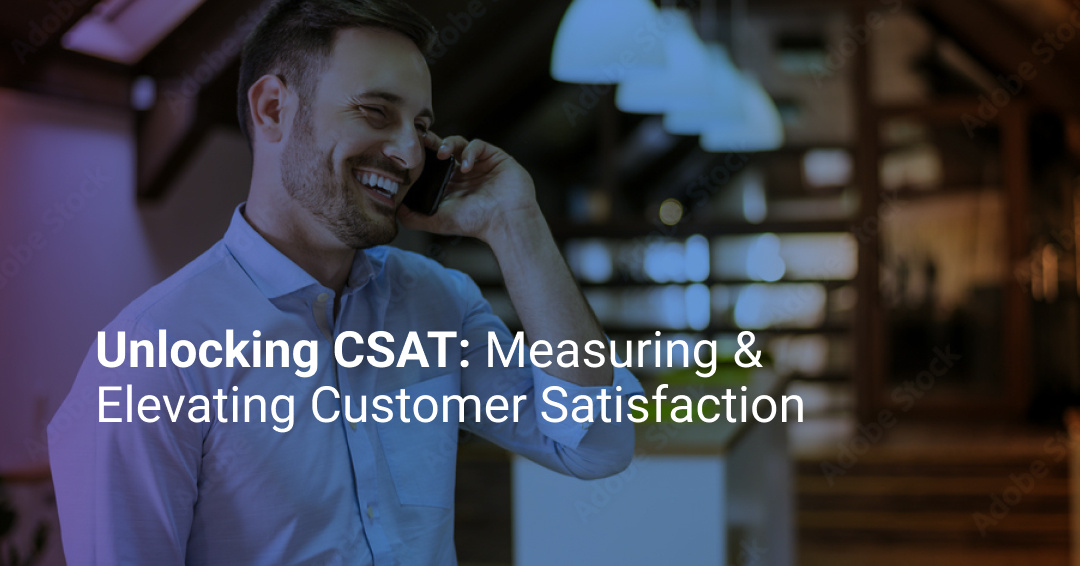12 Call Center Metrics You Should Be Using to Improve CX in 2025
Call center metrics are the most important performance indicators that monitor how effectively your call center is running. This includes anything...

Conversational AI has become immensely popular among businesses, users, and developers. With so many conversational AI platforms on the market, it can be difficult to tell which one offers the features you need for your business.
One popular platform is Google Dialogflow. It is most commonly used as a tool for building text-based chatbots, but it can do a lot more than that. Dialogflow works behind the scenes for many of the most popular customer service solutions, including Mosaicx.
So if it is best known for text-based chatbots, why should you trust voice-based conversational AI using Google Dialogflow? This is because Dialogflow is also widely used for another type of application: voicebots.
A voicebot is a conversational agent that uses artificial intelligence and natural language understanding (NLU) to interpret the intent and meaning in the speech of its conversational partner. Voicebots use input voice recognition and translation (commonly referred to as speech-to-text or STT) alongside a text-to-speech (TTS) engine to understand human speech and respond using everyday language.
Voicebots are similar to chatbots—which interact with users through text-based channels, such as websites and messaging apps—but are designed to be used over the phone or other voice-enabled devices. This allows users to interact with voicebots more naturally, without having to type or use a keyboard. Some examples of voicebots include Siri, Alexa, Google Assistant, Cortana, and Bixby.
Voicebots can be used for a variety of purposes, such as:
There are at least three key characteristics that distinguish an AI-powered voicebot from an IVR. While both are capable of getting the job done, voicebots offer a lot more to businesses, making them a lot more popular in comparison and necessary technology for new and existing businesses to understand.
Customers prefer businesses that respond and address queries quickly. They are unlikely to show patience if forced to go through multiple prompt menus before receiving a worthwhile response. This is what makes IVRs limiting when pitted against voicebots because thanks to AI, voicebots can be trained to have a human-like conversation. Whether designed for conversational AI or generative AI, voicebots can learn about customers from their interactions to quickly resolve their issues or provide satisfactory directions.
Unlike IVRs, the learning capabilities of AI allow voicebots to provide contextual responses. This is important for businesses because while an IVR may keep a customer inside a loop of pre-determined prompts, a voicebot can identify the right moment to let the customer reach an agent. The results? Customers' needs get prioritized. Their issues get fast-tracked. They leave with a positive customer experience.
Another advantage of using AI voicebots is their level of scalability. They can be engineered for complex scenarios to deliver real, accurate answers to customers. IVRs, however, are only as good as their prompts. Their limited functionality means that a customer is likely to disconnect if the first few prompts do not address their issue.
Dialogflow is a powerful and versatile platform provided by Google that is widely used for building chatbots and voicebots. It offers a range of features that make it an excellent choice for developing conversational applications.
The platform is backed by Google's expertise in natural language processing and artificial intelligence. If you've ever talked to Google Assistant on a smartphone or smart speaker, you've experienced some of the best voice-recognition technology on the market. That same technology backs Dialogflow, which ensures that your voicebot can handle complex queries and provide a great user experience.
Other features that make Dialogflow well-suited for voicebots include:
Building a voicebot with Dialogflow starts with creating agents and defining intents. Intents are the reasons customers call. These intents should define what your voicebot can do, such as answering questions, providing information, or completing tasks. You will also need to create entities, which are the words or phrases that your voicebot can understand.
Before starting, though, note that there are two versions. There is the standard agent called Dialogflow ES, and an advanced agent called Dialogflow CX. In general, the standard is for small businesses while the advanced version is suitable for large and complex business needs.
Start by heading into the Google Dialogflow console and creating a new project. Then access it from the same console to create an agent before filling all the fields as necessary. Do note that a single project can have multiple agents, and Google provides prebuilt agents as templates.
You can see how your virtual agent is doing by clicking on “Test Agent” in the top-right corner of the screen. By default, it comes with greetings.
Entities are references for your AI voicebot to understand context. They have unique IDs to let the voicebot call them up during a customer interaction. Hence, the more references (or synonyms) you add, the better. For example, a voicebot for an ice cream parlor can have flavors as its entities. Similarly, an AI-powered virtual agent for a restaurant can have its menu or dishes as references. The voicebot’s purpose narrows down the number of required entities.
Think of flows as conversational topics for your Dialogflow agent. For example, a travel agency can arrange its topics such as travel details, travel pricing, weather updates, etc. Each topic can have multiple conversations that become more complex as they branch out. A good flow will contain all the steps your voicebot takes to complete a task or answer a question.
This is one of the most important steps in building a Dialogflow voicebot. Intents, as the word suggests, allow a voicebot to identify the intention of the customer to move the conversation from one phase to another. Using the travel agency example, one intent might be traveling from Dubai to London.
When defining intents, make sure to provide a list of all possible phrases or queries you expect your customer to say. Google’s AI will also automatically match your entities and intents to create possible phrases.
With flows and intents defined, the next step is to connect them. Head into the flow options and create a new route. Select the right intent and confirm.
This is where you re-check everything to confirm if there is any need for more entities, intents, or conditional triggers. Test your voicebot after every change to see how it performs to complex queries before exporting it for your business.
All of this can be time-consuming. First, you must discover why people call and be sure not to leave out any important intents. Secondly, people may phrase each intent in a hundred different ways. These are your entities. So If a Dialogflow voicebot responds to 50 intents, engineers must program up to 5,000 variant entities.
For example, the voicebot must understand that “Los Angeles,” “Los Angeles International,” “LA,” and “LAX” all describe the same airport.
It's easy to miss intents and entities, but the Mosaicx team helps you navigate these pitfalls. We also continually modify intents and entities over time.
Once the voicebot is ready, you must make it accessible to the public. If your voicebot is great but the underlying infrastructure experiences frequent downtime, you will create a poor customer experience. Understand that your voicebot might work well in testing, but a host of other settings only come into play when used on a large-scale commercial setting.
Mosaicx provides a robust, scalable infrastructure for some of the largest brands in the United States, allowing voicebots to serve their customers via call, text, and other channels.
The main goal of designing an AI voicebot is to help customers (or end-users) resolve their issues without them needing to switch to a human agent. The conversation should be natural, cooperative, and contextual. Here are some of the best practices to keep in mind when designing your Dialogflow voicebot.
Map out your main goals before building a Dialogflow voicebot. Ensure that you clearly understand what the voicebot should achieve, how it aligns with your business strategy, and why it is necessary. This is also where you should set KPIs to measure success. Dialogflow voicebots are not a deploy-and-forget product. They require continual optimizations and modifications to meet your customers' needs.
Voicebots are meant to interact with customers in a human-like manner. That requires natural dialogues that smoothly (and accurately) transition from one state to another. The conversational flow, however, is only as good as the information present in the dialogues. Hence, businesses should ensure they have a list of every possible question a customer might ask along the way alongside dynamic answers for branching conversations.
While AI has automated a lot of our work, you should never deploy a product without extensive testing. Considering how complicated a Dialogflow voicebot can become for large-scale businesses and use cases, double- and triple-check everything before pushing it live. You can often come across something that can be further improved, missed entities, an ambiguous intent, the opportunity to craft a new conversation flow, a badly routed page, etc.
It is important to keep measuring your AI voicebot's performance after deployment. It lets you identify areas where your voicebot might have trouble maintaining a seamless conversational flow for certain customers, products, or interactions in general. Such targeted improvements are only possible when you have access to your voicebot's analytics and its conversational data.
In addition, analyzing data can help sales leaders learn about customer behavior. This can help generate leads to drive campaigns, make informed decisions, improve your products, etc.
Remember that voicebots are meant to speak the language of your customers. They represent your brand in every way, so always be open to improvements or tweaks based on feedback. Send out regular surveys, or contact customers following their calls to learn about their experience. Even the smallest change today might enhance your customer experience ratings for thousands of others tomorrow.
Many small conversational AI platforms have popped up in recent years, but there are still only a couple of true alternatives to DialogFlow.
Although all four are backed by some of the biggest names in tech, Dialogflow offers a number of advantages over its competitors. Here are a few reasons why we use Dialogflow in Mosaicx products.
In addition to these advantages, Dialogflow is also backed by Google's expertise in natural language processing and artificial intelligence. This means you can be confident that your Dialogflow voicebot will handle even the most complex queries and provide your users with a great experience. Here is a table that compares Dialogflow to some of its top competitors.
|
Feature |
Dialogflow |
Amazon |
IBM Watson |
Microsoft Azure |
|
Ease of use |
Easy |
Medium |
Difficult |
Easy |
|
Natural language processing |
Powerful |
Good |
Good |
Powerful |
|
Integrations |
Wide Range |
Limited |
Limited |
Wide Range |
|
Global reach |
Yes |
Yes |
Yes |
Yes |
|
Scalability |
Yes |
Yes |
Yes |
Yes |
At Mosaicx, we believe Dialogflow offers the best technology, experience, and value for voicebot projects of all sizes. That is why we incorporated Dialogflow into our own products. There is no need to create an all-new language model. Using Dialogflow allows us to do what we do best: create industry-specific, ready-to-use products and offer ongoing consultation, optimization, and support.
Speaking of language models, Dialogflow uses the BERT large language model (LLM) for its NLU capabilities. BERT was first introduced in 2018 by Google AI, and it has since become one of the most popular and widely used language models for natural language processing (NLP) tasks.
BERT is a bidirectional encoder representation from the transformers model. This means that it can learn the context of words in a sentence, both before and after the word. This makes it more powerful than previous language models, which could only learn the context of words in a sentence from left to right.
Dialogflow CX, the newer version of Dialogflow, uses a BERT-based NLU model by default. Dialogflow ES, the older version of Dialogflow, can also use a BERT-based NLU model, but it is not enabled by default. To use a BERT-based NLU model in Dialogflow ES, you need to enable the "Experimental Features" flag in the Dialogflow console.
Here are some of the benefits of using the BERT language model in Dialogflow:
Overall, the BERT language model in Dialogflow makes it a more powerful and versatile NLP platform for building conversational interfaces.
BERT is very large. The base version of BERT has 110 million parameters, and the larger version has 340 million parameters. This makes it more computationally expensive to train than smaller language models, but it also allows it to learn more complex relationships between words.
BERT is effective at a variety of NLP tasks, including:
The best large language model is a matter of opinion, but some of the most popular and well-regarded models include:
Ultimately, the best large language model for you will depend on your specific needs and requirements. If you need a model that can perform a variety of tasks, GPT-4 or Turing NLG may be a good choice. If you need a model that can generate human-quality text, PaLM or LaMDA may be a better option. It is important to note that large language models are still under development, and are constantly being improved.
Although GPT-4 has gotten a lot of attention, it is not always the best LLM. BERT excels at tasks that require understanding the context of words in a sentence, such as question answering and natural language inference. This is because BERT is a bidirectional model, which means that it can learn the context of words in a sentence from both before and after the word.
GPT-4 is better at tasks that require generating text, such as summarization and translation. This is because GPT is an autoregressive model. It can predict the next word in a sequence given the previous words.
Here is a table that summarizes the key differences between BERT and GPT-4.
|
Feature |
BERT |
GPT-4 |
|
Model type |
Bidirectional encoder |
Autoregressive |
|
Strengths |
Understanding the context of words, question answering, natural language inference |
Generating text, summarization, translation |
|
Weaknesses |
Generating text, summarization, translation |
Understanding the context of words, question answering, natural language inference |
In general, BERT is better for tasks that require understanding the meaning of text, while GPT is better for tasks that require generating text. These differences make BERT (and Dialogflow) a better option for chatbots and voicebots.
For all these reasons, we trust Dialogflow when building Mosaicx voicebots. Choosing a conversational AI platform, though, is just step one. Next are the four steps to build, train, test, and deploy a conversational AI solution.
Is Dialogflow voicebot free?
No, it is not. Dialogflow charges a monthly fee for each of its editions: Dialogflow CX and Dialogflow CS. The final price depends on the number of requests made during the month. First-time customers, however, can activate a free trial of Dialogflow CX with $600 credit that expires in a year.
Can I build a Dialogflow voicebot myself?
Dialogflow CX is not beginner-friendly. It has an overwhelming interface and requires you to have previous knowledge of creating (and using) voicebots.
Dialogflow ES, however, is easy to use and set up your first voicebot. Several tutorials found on the web can guide you through the building process. That said, the difficulty of creating a voicebot ultimately increases with your requirements.
How do Mosaicx voicebots use Dialogflow?
Mosaicx uses Dialogflow in a wide range of its customer service solutions. It provides ready-to-use AI-powered products that are specifically tailored for industry-specific businesses and brands. Every Dialogflow intent, entity, page, and flow is continually modified over time for further optimizations.

Call center metrics are the most important performance indicators that monitor how effectively your call center is running. This includes anything...

Businesses across industries have changed or evolved over the decades, but one thing that has remained the same is that their growth is pretty much...

Customers have several major expectations from modern businesses, but none is as challenging as them reading your mind to anticipate support you...